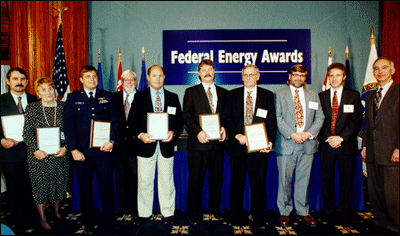2004 Presidential Leadership Award for the Air Force Renewable Energy Team
This award is designed to promote leadership in federal employees. The expertise and learning gathered in the Ascension Island Renewable and FE Warren energy projects helped INL experts become key technical team members of the U.S. Air Force Renewable Energy Team. This team assessed renewable energy across the nation at Department of Defense facilities, installed many assessment systems, and recommended energy procurement and installation guidelines. The team's work will benefit energy managers at many defense bases for years to come.
2004 Air Force National Design Excellence Award
This award was based on the Ascension Phase 2 wind farm and recognizes the difficulties of integrating large wind installations with diesel power plants, desalination systems and solar energy systems without impacting the mission and while saving millions of dollars for the next 20 years. This award was based on the design of an operating facility that increased fuel savings to more than a million gallons of fuel every year while producing more than 17 million gallons of water annually without burning fuel oil. The energy produced from the additional wind turbines produces enough energy to make all water and offset most of the diesel fuel consumed for electrical power.
1997 Federal Energy Management Program Award
Every year the Department of Energy awards federal agencies for outstanding work in saving energy. In 1997, INL received an award in this program for its role as the design team on the Air Force team that won the Small Group Award for the Ascension Wind Farm. This wind farm, commissioned in the fall of 1996, and produces 3.2 million kilowatt-hours of electricity every year and saves more than 250,000 gallons of fuel. The Space Command Award Winning Team is pictured below.
Renewable Energy Awards to Small Groups

In Fiscal Year 1996, thanks in part ot the efforts of this team, the Air Force Space Command compled construction of four 225-kilowatt wind generators at its remote tracking station on Ascension Island to supplement electrical power supplied by fuel oil engine driven generators at its remote tracking station on Ascension Island. This wind energy project was actively pursued due to the remote location of the island and the cost associated with fuel oil shipments. The wind machines are uniquely designed to allow kilowatts for low wind levels that would normally put the generator in a non-producing mode. This feature takes significant advantage of the wind environment at the site. During its first 4 months of operation, the wind farm produced more than 1 million kilowatt hours of electricity. In addition, emissions of the greenhouse gases carbon dioxide and nitrous oxides were reduced by 930,000 pounds and 32,000 pounds, respectively. With an average wind speed on the island of 16 to 17 miles per hour, the wind generators are expected to produce from 3 to 3.5 million kilowatt-hours of electrical energy annually. Fuel oil consumption is expected to be reduced by 287,000 gallons for an annual savings of $350,000.
This project has been an excellent example of how team work can save emissions, fuel and money.

